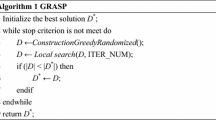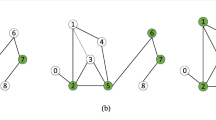Abstract
The minimum independent dominating set problem (MIDS) is an extension of the classical dominating set problem with wide applications. In this paper, we describe a greedy randomized adaptive search procedure (GRASP) with path cost heuristic for MIDS, as well as the classical tabu mechanism. Our novel GRASP algorithm makes better use of the vertex neighborhood information provided by path cost and thus is able to discover better and more solutions and to escape from local optimal solutions when the original GRASP fails to find new improved solutions. Moreover, to further overcome the serious cycling problem, the tabu mechanism is employed to forbid some just-removed vertices back to the candidate solution. Computational experiments carried out on standard benchmarks, namely DIMACS instances, show that our algorithm consistently outperforms two MIDS solvers as well as the original GRASP.


Similar content being viewed by others
Explore related subjects
Discover the latest articles, news and stories from top researchers in related subjects.References
Erciyes K, Dagdeviren O, Cokuslu D et al (2007) Graph theoretic clustering algorithms in mobile ad hoc networks and wireless sensor networks. Appl. Comput. Math 6(2):162–180
Chen Y, Liestman A, Liu J (2004) Clustering algorithms for ad hoc wireless networks. Ad Hoc and Sensor Networks 28:76
Lin CR, Gerla M (1997) Adaptive clustering for mobile wireless networks. Selected Areas in Communications, IEEE Journal on 15(7):1265–1275
Nocetti FG, Gonzalez JS, Stojmenovic I (2003) Connectivity based k-hop clustering in wireless networks. Telecommunication systems 22(1–4):205–220
Basagni S (1999) Distributed clustering for ad hoc networks. In: Proceedings of the 1999 international symposium on parallel architectures, algorithms and networks. IEEE Computer Society, pp 310–315
Stankovic JA (2008) Wireless sensor networks. Computer 10:92–95
Santos AC, Bendali F, Mailfert J et al (2009) Heuristics for designing energy-efficient wireless sensor network topologies. Journal of networks 4(6):436–444
Akyildiz IF, Kasimoglu IH (2004) Wireless sensor and actor networks: research challenges. Ad Hoc Netw 2(4):351–367
McLaughlan B, Akkaya K (2007) Coverage-based clustering of wireless sensor and actor networks. In: IEEE international conference on pervasive services. IEEE, pp 45–54
Michael RG, David SJ (1979) Computers and intractability: a guide to the theory of NP-completeness. WH Freeman, San Francisco
Halldórsson MM (1993) Approximating the minimum maximal independence number. Information Processing Letters 46(4):169–172
Goddard W, Henning MA (2013) Independent domination in graphs: a survey and recent results. Discrete Mathematics 313(7):839–854
Johnson DS, Yannakakis M, Papadimitriou CH (1988) On generating all maximal independent sets. Information Processing Letters 27(3):119–123
Moon JW, Moser L (1965) On cliques in graphs. Israel journal of Mathematics 3(1):23–28
Gaspers S, Liedloff M (2006) A branch-and-reduce algorithm for finding a minimum independent dominating set in graphs. Graph-theoretic concepts in computer science. Springer, Berlin, pp 78–89
Liu C, Song Y (2006) Exact algorithms for finding the minimum independent dominating set in graphs. Algorithms and computation. Springer, Berlin, pp 439–448
Bourgeois N, Della Croce F, Escoffier B et al (2013) Fast algorithms for min independent dominating set. Discrete Applied Mathematics 161(4):558–572
Cai SW, Su KL, Luo C et al (2013) Numvc: an efficient local search algorithm for minimum vertex cover. J Artif Intell Res 46:687–716
Huang P, Yin M (2014) An upper (lower) bound for max (min) CSP. Science China Information Sciences 57(7):1–9
Gao J, Wang J, Yin M (2015) Experimental analyses on phase transitions in compiling satisfiability problems. Science China Information Sciences 58(3):1–11
Li X, Yin M (2015) Modified Cuckoo search algorithm with self adaptive parameter method. Inf Sci 298:80–97
Wang YY, Ouyang DT, Zhang L et al (2015) A novel local search for unicost set covering problem using hyperedge configuration checking and weight diversity. Sci China Inf Sci. doi:10.1007/s11432-015-5377-8
Wang YY, Cai SW, Yin MH (2016) Two efficient local search algorithms for maximum weight clique problem. In: AAAI
Li X, Zhang J, Yin M (2014) Animal migration optimization: an optimization algorithm inspired by animal migration behavior. Neural Comput Appl 24(7–8):1867–1877
Li X, Wang J, Yin M (2014) Enhancing the performance of cuckoo search algorithm using orthogonal learning method. Neural Comput Appl 24(6):1233–1247
Li X, Yin M (2014) Self adaptive constrained Artificial Bee Colony for constrained numerical optimization. Neural Comput Appl 24(3–4):723–734
Li R, Hu S, Wang Y, Yin M A local search algorithm with tabu strategy and perturbation mechanism for generalized vertex cover problem. Neural Comput Appl. doi:10.1007/s00521-015-2172-9
Festa P, Resende MGC (2002) GRASP: an annotated bibliography. Essays and surveys in metaheuristics. Springer, Berlin, pp 325–367
Festa P, Resende MGC (2009) An annotated bibliography of GRASP–Part I: algorithms. International Transactions in Operational Research 16(1):1–24
Festa P, Resende MGC (2009) An annotated bibliography of GRASP–Part II: applications. International Transactions in Operational Research 16(2):131–172
Glover F (1997) Tabu search and adaptive memory programming—advances, applications and challenges. Interfaces in computer science and operations research. Springer, Berlin, pp 1–75
Glover F (1989) Tabu search-part I. ORSA Journal on computing 1(3):190–206
Glover F (1990) Tabu search—part II. ORSA Journal on computing 2(1):4–32
Johnson DS, Trick MA (1993) Cliques, coloring, and satisfiability: second DIMACS implementation challenge, vol 26. American Mathematical Society, Providence
Aiex RM, Resende MGC, Ribeiro CC (2007) TTT plots: a perl program to create time-to-target plots. Optimization Letters 1:355–366
Acknowledgments
The authors of this paper express sincere gratitude to all the anonymous reviewers for their hard work. This work was supported in part by NSFC under Grant Nos. (61272208, 61370156, 61403076, 61403077, 61402196), Program for New Century Excellent Talents in University (NCET-13-0724), and Jilin Province Science and Technology Development Plan under Grant Nos. (20140520067JH).
Author information
Authors and Affiliations
Corresponding author
Rights and permissions
About this article
Cite this article
Wang, Y., Li, R., Zhou, Y. et al. A path cost-based GRASP for minimum independent dominating set problem. Neural Comput & Applic 28 (Suppl 1), 143–151 (2017). https://doi.org/10.1007/s00521-016-2324-6
Received:
Accepted:
Published:
Issue Date:
DOI: https://doi.org/10.1007/s00521-016-2324-6




